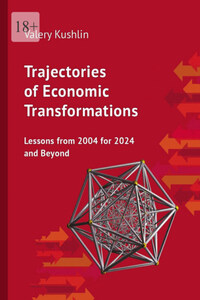Kushlin Valery
Trajectories of Economic Transformations: Lessons from 2004 for 2024 and Beyond / Valery Kushlin. – Ekaterinburg : Издательские решения, 2024. – 346 p.
ISBN 978-5-0064-6474-2
The first English-language edition of a landmark 2004 work by a prominent Russian economist, Professor Valery Kushlin, offers profound insights into the painful challenges and crossroads of Russia’s post-socialist transition, nesting them in the 21st century’s emerging global socioeconomic trends and contradictions. Twenty years after the book’s original publication, its key observations on the nature of economic transformations strongly resonate in the context of contemporary global challenges.
Translated and edited by Andrey V. Kushlin, 2024.
Cover design by Ivan A. Zherebtsov, 2024.
All rights reserved.
© Valery Kushlin, 2024
ISBN 978-5-0064-6474-2
Created with Ridero smart publishing system
The modern world economy is a complex combination of transnational structures and national economic systems of different scales and levels. There is much to be said about the increased interdependence of economic systems in the world and the dynamism of economic and socio-political changes. But no matter how economic interactions in the world change, most people judge them by what happens in their home country. The peoples of Russia, as well as the peoples of several other countries. In the last decade of the 20th century, they were involved in transformations that were very sensitive to them, which primarily took over the economy and, through this, all areas of people’s lives. These transformations were initiated by the conscious actions of the most active representatives of the country’s elites and tacitly supported by the people. From the very beginning, they acquired the character of purposeful changes in the economic system, so it became appropriate to talk about the policy of economic transformations.
Although these transformation processes started a long time ago, and mountains of literature have already been written about them, the comprehension of what is happening not only does not seem complete, but with each step from the old to the other, it gives rise to more and more questions that do not receive explanations. Among such questions are both directly mundane, pragmatic, related to the lives of people today and tomorrow, and conceptual, worldview, related to the understanding of the driving forces and patterns of qualitative and quantitative changes in the economy and society.
The focus is rightly on changes in the economic system, which also determine other qualitative features of society. In studying them, it is important to agree on fundamental approaches related to the understanding of the general and the specifics. Since economic transformations have occurred many times in the history of countries and peoples, there is a natural desire to use the facts of history and their systematization in literature to derive the laws of economic transformations. applicable to today. Such an approach cannot be excluded, but neither can it become the main method of analysis. The transformations of the economic system that have unfolded today in Russia and other post-socialist countries cannot be adjusted in terms of content and consequences to analogues in the past. They are truly unique and need to be approached in all their complex concreteness. It is also necessary to consider the very complex relationship between the transformation processes in the countries of the post-socialist zone and the rest of the world economy. These external blocs are influencing post-socialist countries more strongly than in the past, and not necessarily positively. The increasingly contradictory development of events in the world economy, including in the system of economies of countries that have always seemed stable, gives rise to expectations of serious transformations in themselves along not entirely clear trajectories.
These considerations have predetermined our approach to the chosen topic of economic transformation. We will talk about the content and methods of transforming the Russian economy as a particularly complex phenomenon that does not fit into some known schemes, but at the same time as a process that is part of contradictory economic and socio-political transformations around the world.
When analyzing such complex transformational phenomena, the question inevitably arises about their causes and effects, about real (and hidden) goals, and about the trajectories of progress towards them.
The word “trajectories” in the title of this book is somewhat symbolic. It denotes the need for the economic systems of all countries to move towards new states in order to overcome global contradictions, and at the same time emphasizes the limitations of managerial influences on these advances. It is no coincidence that the concept of “trajectory” is taken here in the plural. I proceeded from the fact that there are a great many ways to transform the economy in each country. Moreover, the endpoints of each of the trajectories are also not unambiguous, but multivariate. The goals achieved by economic transformations are clarified and concretized only in the course of the practice of transformations. This means that the analysis of transformation trajectories should include a constant clarification of the content of transformations and their goals.








